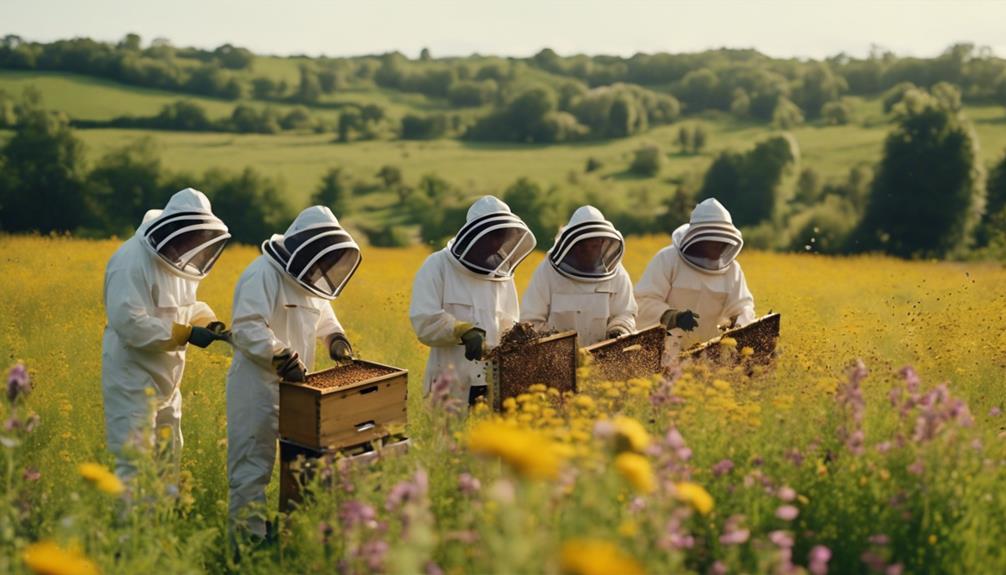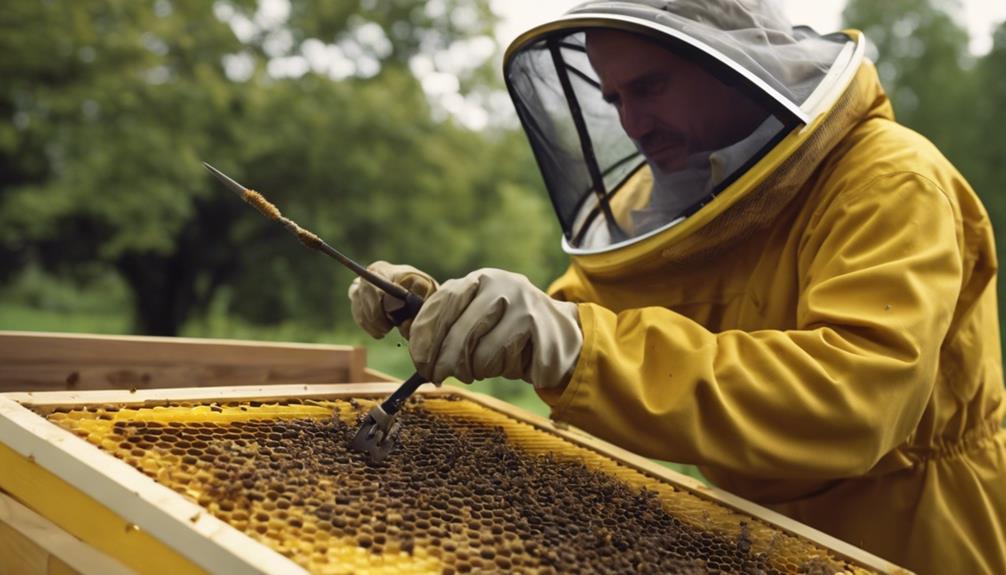When spotting a Carniolan honey bee, focus on their dark color with brown spots or bands on the abdomen, a distinct feature of this bee subtype. These bees adjust brood production swiftly according to nectar availability, display a gentle demeanor, and boast remarkable disease resistance. Understanding their behavior, genetics, and even conducting wing analysis can aid in accurate identification. The collaboration in breeding programs and the preservation of genetic purity play significant roles in safeguarding Carniolan bee genetics. The combination of physical traits and behavioral characteristics makes the Carniolan honey bee a fascinating subject for study.
Main Points
- Dark coloration with brown spots or bands on the abdomen.
- Gentle nature and behavior.
- Rapid adjustment in brood production based on nectar availability.
- Key behavioral traits for identification.
- Conducting wing analysis for distinguishing features.
Physical Characteristics of Carniolan Bees
When observing Carniolan bees, their distinctive dark coloration with brown spots or bands on the abdomen immediately sets them apart from other bee subspecies. This unique coloring not only makes them aesthetically pleasing but also serves as a practical way for beekeepers to identify them.
In addition to their dark appearance, Carniolan bees are known for being gentle, making them a favorite among beekeepers for their easy handling. Another fascinating trait of these bees is their rapid adjustment in brood production based on nectar availability, showcasing their adaptability in changing conditions.
Additionally, their excellent disease resistance further highlights the resilience of Carniolan bees, making them a valuable asset in maintaining healthy bee populations.
Importance of Behavior in Identification
Identifying a Carniolan Honey Bee can be significantly aided by understanding the importance of their behavior in the identification process. These bees are known for their gentle temperament, making them easier to approach and handle compared to other bee subspecies.
Their ability to adjust worker population based on nectar availability is a key behavioral trait that helps in recognizing them. Carniolan honey bees exhibit a remarkable importance to diseases, which is a critical factor in their identification.
Observing these behaviors can provide valuable clues when differentiating Carniolan bees from other types. So, keep an eye out for their gentle nature, worker population adjustments, and disease resistance when trying to identify these beneficial insects in the wild.
Collaborative Breeding Programs for Carniolan Bees
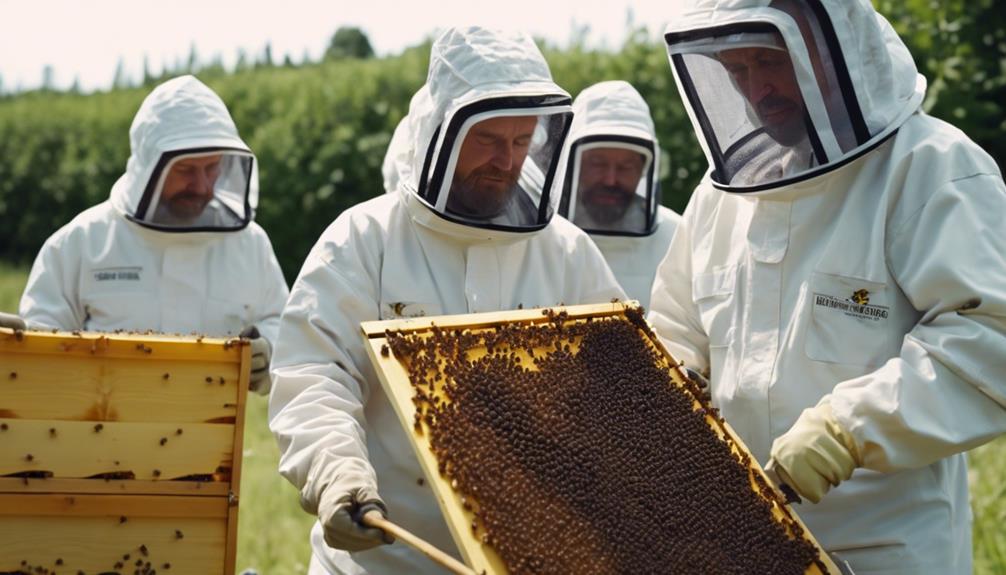
Collaborative breeding programs for Carniolan bees focus on preserving the genetic purity and enhancing desirable traits of this honey bee subspecies through partnerships between beekeepers and researchers. By working together, we guarantee that Carniolan bee populations maintain their unique characteristics, such as gentleness, disease resistance, and ability to thrive through winter.
Through selective breeding techniques and specialized insemination methods, these programs aim to safeguard the integrity of Carniolan bee genetics. This collaboration not only benefits the bees themselves but also provides beekeepers with access to authentic Carniolan queens, supporting those interested in promoting and maintaining this particular subspecies.
Through these initiatives, we contribute to the conservation and improvement of Carniolan bees for future generations to enjoy.
Understanding Bee Genetics for Identification
Exploring the genetic markers that distinguish different bee subspecies enhances our ability to accurately identify Carniolan honey bees in beekeeping practices. When delving into bee genetics for identification, here are some key points to take into account:
- Genetic Variation: Understanding the genetic makeup of Carniolan honey bees helps in distinguishing them from other subspecies like Italian honey bees.
- Inheritance Patterns: Certain traits, such as coloration and behavior, are passed down through specific genetic pathways in Carniolans.
- DNA Analysis: Utilizing modern genetic techniques allows for precise identification of Carniolan honey bees based on their unique genetic markers.
- Population Studies: Researching the genetic diversity within Carniolan populations aids in maintaining the purity of this subspecies for beekeeping purposes.
Conducting Wing Analysis for Bee Identification
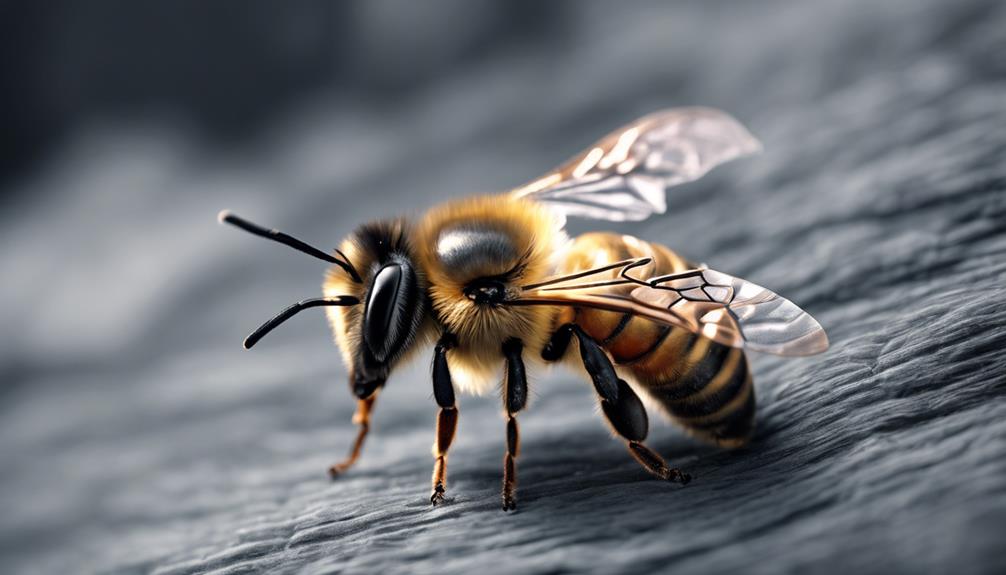
When analyzing bee wings for identification, key factors like wing vein patterns, size comparisons, and color markings play a vital role in distinguishing Carniolan honey bees from other subspecies. These intricate details provide valuable insights into the genetic characteristics of the bees, aiding beekeepers and researchers in maintaining the purity of Carniolan honey bee populations.
Wing Vein Patterns
Examining the intricate vein patterns on a bee’s wings is a key step in identifying Carniolan honey bees within a colony. When analyzing wing vein patterns, here are some essential points to keep in mind:
- Unique Characteristics: Carniolan honey bees have distinct wing vein patterns that distinguish them from other bee races.
- Identification Method: Conducting wing analysis is a reliable way for beekeepers and researchers to determine the genetic makeup and race of honey bees.
- Comparison with Other Races: By recognizing the subtle differences in wing vein patterns, it becomes easier to distinguish Carniolan bees from Italian, Russian, or other bee races.
- Accurate Identification: Mastering the art of interpreting these patterns helps precisely pinpoint Carniolan honey bees in a diverse colony of bees.
Size Comparison Analysis
To accurately differentiate Carniolan honey bees from other bee races within a colony, we analyze their wing size in comparison to their body proportions. When conducting wing analysis for bee identification, we pay close attention to the size of the Carniolan honey bee’s wings relative to its body.
This method helps us distinguish Carniolan bees from other honey bee races like Italian bees. The significant wing characteristics of Carniolan bees play a vital role in this identification process. By comparing the wing size of different honey bee races, we can pinpoint the Carniolan honey bees based on their distinct wing proportions.
This size comparison analysis is a valuable tool for beekeepers and researchers aiming to accurately identify Carniolan honey bees in a bee population.
Color Markings Examination
Conducting color markings examination is essential for accurately identifying Carniolan honey bees. When examining these bees, look for their dark coloration, often with brown spots or bands on the abdomen. Here’s a quick guide to conducting wing analysis for bee identification:
- Dark Coloration: Carniolan honey bees typically have a darker hue compared to other bee species, making them stand out visually.
- Brown Spots: The presence of brown spots or bands on the abdomen is a key indicator of Carniolan bees, helping differentiate them from other varieties.
- Abdomen Examination: Focus on observing the abdomen closely, as the unique markings on this body part can reveal important information about the bee’s species.
- Wing Analysis: Pay attention to the wings’ characteristics, as wing analysis plays an essential role in accurately identifying Carniolan honey bees.
Observing Swarm Behavior in Bee Identification
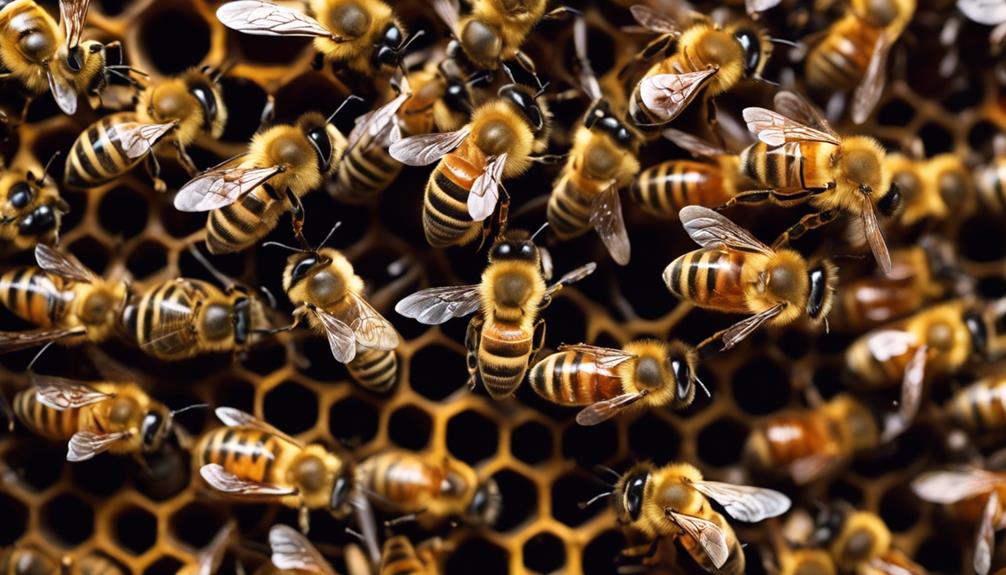
How can swarm behavior assist in identifying Carniolan honey bees?
In terms of bee races, Carniolan honey bees are known for their frequent swarming habits. Observing swarm behavior in these bees can be a valuable tool for identification.
As Carniolan bees get ready to swarm, you might notice them preparing to leave the hive, typically with their queen leading the way. During this process, they may gather in a cluster on a nearby object before relocating to establish a new hive.
These unique genetic traits related to swarming tendencies are key markers that can help beekeepers differentiate Carniolan honey bees from other races. By understanding and recognizing these behaviors, beekeepers can effectively interact with and manage Carniolan colonies.

Hello! My name is Noel Calvin. I graduated from UCLA and now work as a writer at Launch Ninjas. I write blog posts that inspire and guide our readers in their entrepreneurial pursuits. I live in Pleasantville, NJ, with a peaceful yet lively atmosphere that inspires me.
Writing stories is more than just a job for me. It allows me to share my observations and satisfy my curiosity about the world. I combine my analytical skills with creative enthusiasm to delve into technology trends and startup stories. But my life isn’t limited to screens and keyboards. I value loyalty, passion, and a touch of old-fashioned charm, which I infuse into every narrative I create.
I love spending time in my garage, jamming with my band when I’m not writing. Playing the guitar and singing bring me immense joy. I also enjoy capturing ordinary and extraordinary moments through my camera lens and exploring new culinary adventures that excite my taste buds. I’m always seeking new experiences.
My family is very important to me. Joyful Sunday brunches filled with laughter and intense board game nights keep me grounded, reminding me of life’s simple pleasures.
In my world, every moment is an opportunity for discovery. Every discovery is a story worth sharing, whether a heartfelt moment at home or the pulse of technological innovations. Join me as I navigate through life, one blog post, one guitar strum, and one heartwarming family dinner at a time.

